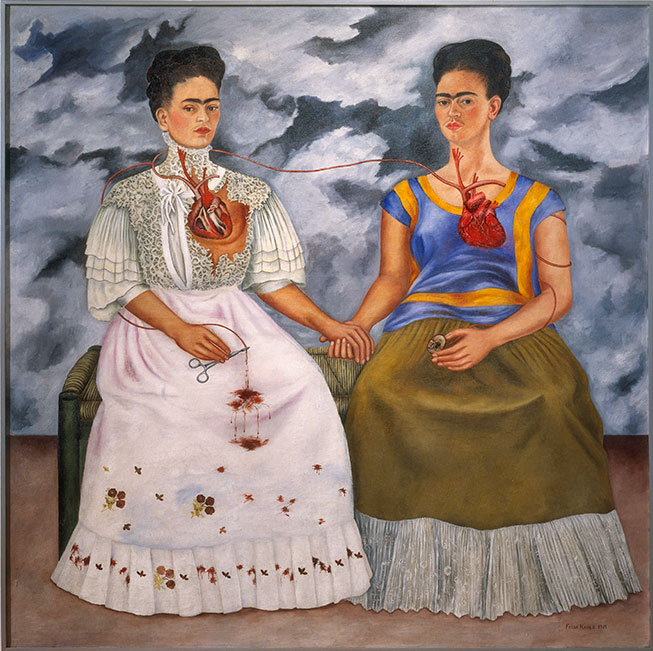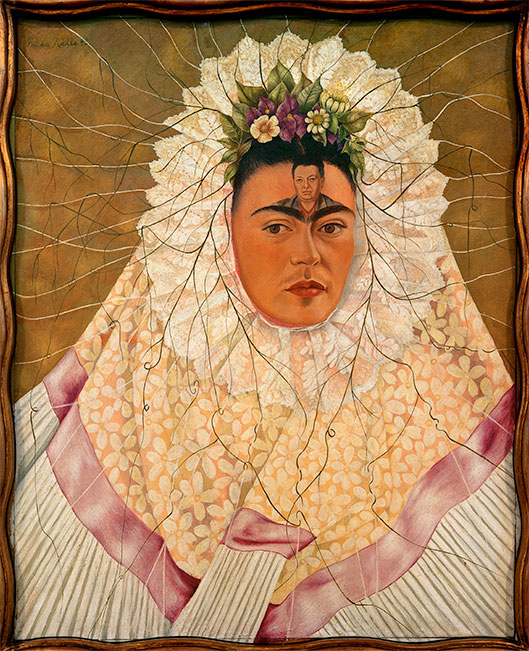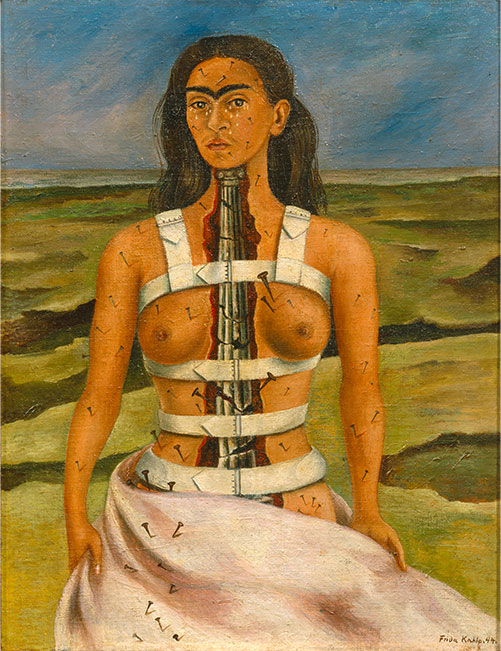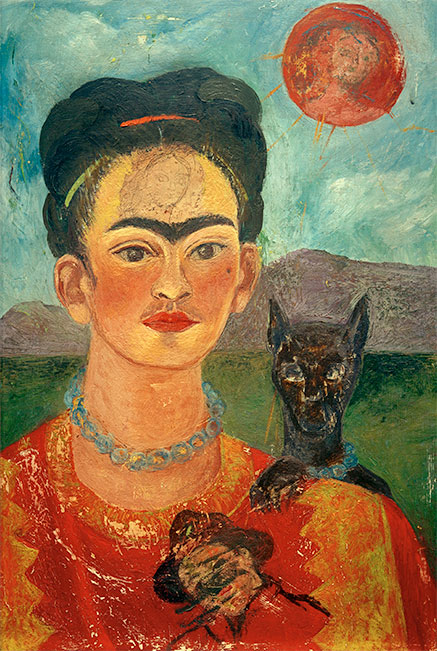Frida Kahlo’s 5 Self-Portraits: a Life in 5 Masterpieces
Frida Kahlo’s self-portraits are world-famous and the intensity of her gaze unmistakable. Why do her paintings captivate us? What details are we missing when we look at them? Let’s take a closer look at some of the images that have made the Mexican artist one of the most influential women in the history of art.
1. The Two Fridas (1939)
Frida Kahlo said that this work represents the “duality of her character”. Indeed, this mirror game illustrates the artist’s dual heritage: European (the figure in the Victorian dress) and indigenous (the one wearing the tehuana skirt and blouse).
It is an image with surreal elements that illustrate loneliness and lovelessness. Like other works in which the artist doubles herself, The Two Fridas symbolises the consolation she offers herself in moments of despair. Today it is one of the most visited paintings in the Museum of Modern Art in Mexico City.

The two Fridas, 1939. Museum of Modern Art, Mexico City.
© By Agostini Picture Library / G. Dagli orti
© 2021 Banco de México Diego Rivera & Frida Kahlo Museums Trust. Av. 5 de Mayo No. 2, col. Center, alc. Cuauhtémoc, c.p. 06000, Mexico City
2. Self-Portrait with Thorn Necklace and Hummingbird (1940)
Frida felt a strong connection with the hummingbird, even turning her characteristic eyebrows into the wings of the little bird in one of her paintings in 1946. The hummingbird also has another connotation: people in Mexico used it as an amulet to conjure luck in love.
The thorn necklace and open wounds in the painting are symbolic of Christianity. The influence of Mexican votive offerings, popular representations of religious motifs, is very much present in the way the artist depicted her personal suffering.

Self-Portrait with Thorn Necklace and Hummingbird, 1940. Nickolas Muray Collection.
© Harry Ransom Center. The University of Texas at Austin
© 2021 Banco de México Diego Rivera & Frida Kahlo Museums Trust. Av. 5 de Mayo No. 2, col. Center, alc. Cuauhtémoc, c.p. 06000, Mexico City
3. Self Portrait as a Tehuana or Diego in my Thoughts (1943)
Frida wore her favourite clothing (and also that of Diego Rivera) both in public and in many of her paintings: the dress worn by the women of the Isthmus of Tehuantepec, of Zapotec ethnicity, much admired for their sensuality, intelligence and courage.
Rivera’s face, which always occupied a place in the artist’s mind and heart, is depicted on Frida’s forehead. Frida began to paint this piece in 1940, the year of her divorce from the painter, but did not finish it until 1943. It is the representation of an obsessive presence, one that never fades despite their split.

Self-portrait of Tehuana or Diego in my thought, 1943. Collection Jacques and Natasha Gelman of Mexican Art of the s. xx and Fundación Vergel.
© Album / akg-images.
© 2021 Banco de México Diego Rivera & Frida Kahlo Museums Trust. Av. 5 de Mayo No. 2, col. Center, alc. Cuauhtémoc, c.p. 06000, Mexico City.
4. The Broken Column (1944)
An event that marked her life forever was the accident she was in at the age of 18. She survived a series of major injuries (including a multiple fracture of the spine) but was bedridden for months and the after-effects were to last a lifetime.
In 1944, after surgery that once again left her bedridden, unable to move, she bared her soul in The Broken Column. The combination of realistic elements (the metal corset) and symbolic ones (the nails, the broken spine) convey the anguish of her physical and emotional pain. However, despite the tears, her gaze reflects strength: this is a portrait of a woman unwilling to give up.

The broken column, 1944. Oil on masonite, 39 x 30.5 cm. Dolores Olmedo Museum, Mexico City.
© Album
© 2021 Banco de México Diego Rivera & Frida Kahlo Museums Trust. Av. 5 de Mayo No. 2, col. Center, alc. Cuauhtémoc, c.p. 06000, Mexico City
5. Self Portrait with a Portrait of Diego on the Breast and Maria Between the Eyebrows (1953-1954)
In her final years, Frida suffered such severe pain that she could hardly paint without resorting to medication. Despite the challenges, the personality of her work always found its way through, as reflected in this painting, one of her last known self-portraits, which she managed to finish the same year she died. It once again evokes her passion for Diego Rivera, whom she never wanted to forget.
With a note of irony, the painting also includes actress María Félix, one of Rivera’s lovers. However, there was no sense of resentment involved: the two women were always close friends. And the image of Diego Rivera appears, perhaps for the last time, portrayed close to the artist’s heart.

Self-portrait with Diego on my chest and María (Félix) on my eyebrows, 1953-1954. Particular collection.
© Album / akg-images.
© 2021 Banco de México Diego Rivera & Frida Kahlo Museums Trust. Av. 5 de Mayo No. 2, col. Center, alc. Cuauhtémoc, c.p. 06000, Mexico City.
Discover The Dreams of Frida Kahlo with ARTIKA
- ARTIKA presents the first work that brings to light the lesser-known facet of Frida Kahlo: her paintings.
- The Dreams of Frida Kahlo: a limited edition that unveils the secrets, passions, fears and fantasies of a 20th-Century icon.
